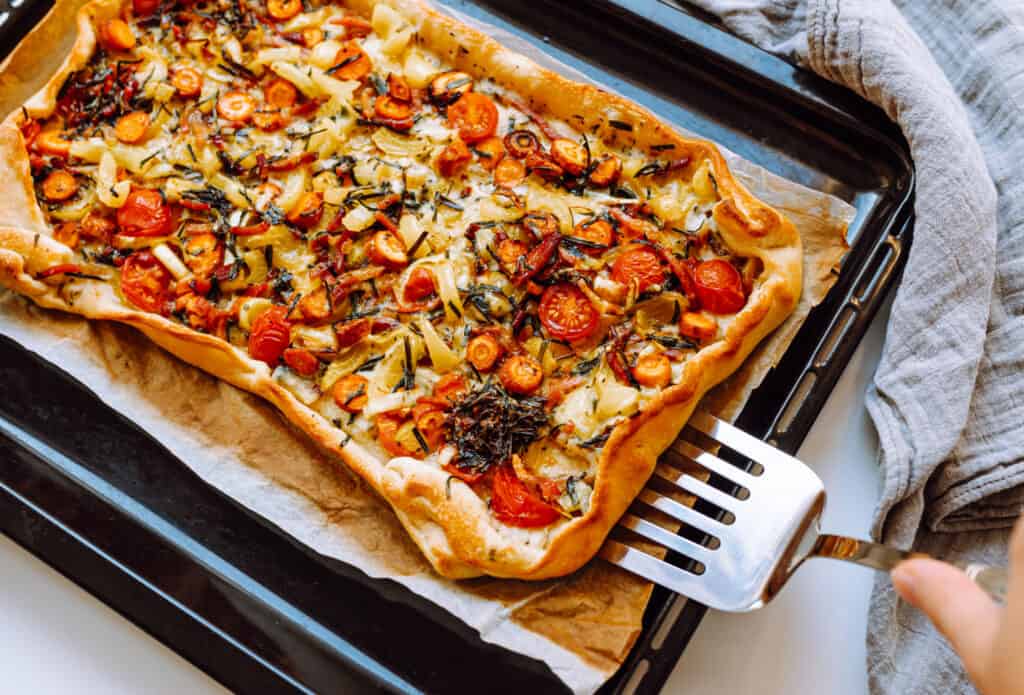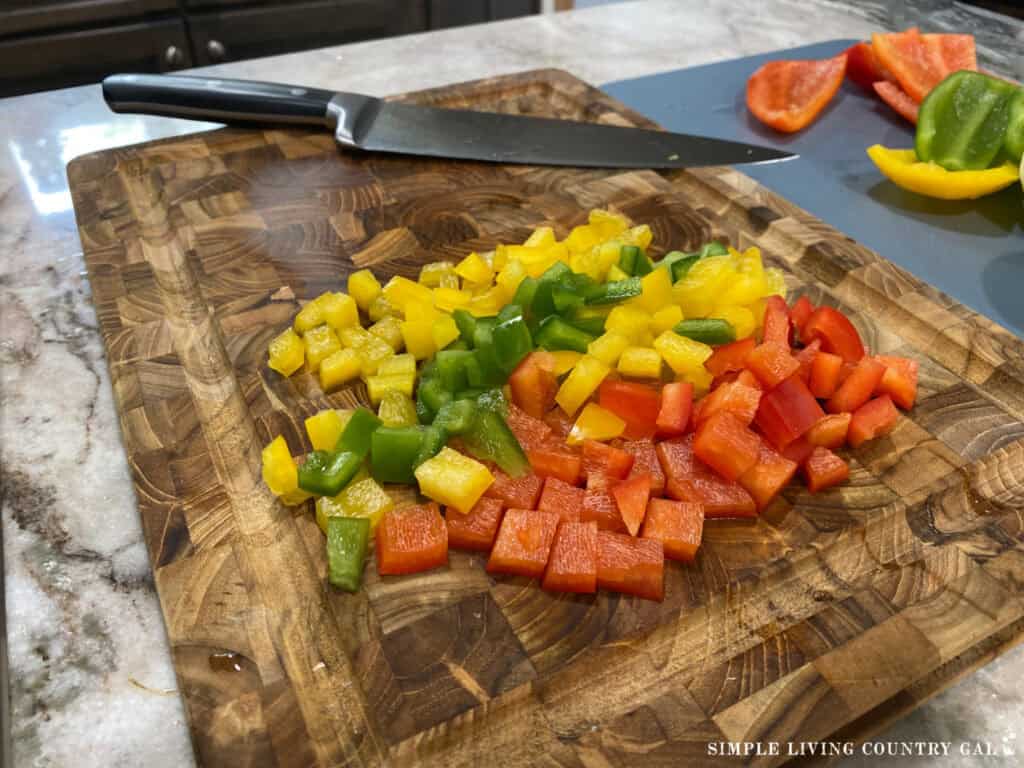Create a Weekly Menu
Let’s face it. Food is getting really expensive. When you create a weekly menu, you are more in control of the food you buy, the food you eat, and the food you end up tossing in the compost bin. I am all about easy, and today I have my very best tips that will have you loving meal planning and how quickly you can set one up full of easy meals you love.
Living a simple life all centers around saving money and creating efficient ways of doing everyday tasks.

How to Create a Weekly Menu
Planning a weekly menu is a great way to save money. Period. It is also a great way to save your sanity, because there is nothing quite as frustrating as tossing spoiled or expired food.
By building a dinner plan around the foods you already have in your fridge, freezer, and pantry, you can turn your food storage areas into an extension of your kitchen.
What are the Benefits of Meal Planning?
#1. A pre-planned weekly menu means you always know what to make each night. This removes that mad rush that seems to hit us like clockwork every day at 5 pm.
#2. Meal plans save money because they dictate exactly what you need to purchase at the grocery store. This also saves time each week and reduces impulse purchases and even food waste.
#2. A menu allows you to plan for healthy, balanced meals, cutting back on junk food and fast food stops.
In a nutshell, menu planning is a key part of living a simple and more efficient life. Yes, it does take some planning in the beginning, but soon, this will become a weekly routine that you can rely on.
If you have not tried or successfully created and used a meal plan, this step-by-step guide will help break it down, making it all easier to do. Give it just one month and see if a meal plan isn’t the most efficient tool in your kitchen!

How to Create a Weekly Menu
There is more to creating a meal plan than a piece of paper and a pen. Maybe that’s why so many people get stuck.
Before you can sit down and start planning dinner ideas, there are a few things you will want to do first. Each step is important in its own way, and I want to encourage you to do them all, especially if this is your first time out.
Macroclo Plastic Clipboards, Acrylic Clear Clip Board 8.5×11 for Classroom, Students, Kid, Woman, Letter Size A4 Transparent Clipboards Size 9


Step 1: Inventory Check
Check what you already have in your pantry, fridge, and freezer, and use that inventory to help plan meals. This one tip can save quite a bit of money on your overall food budget and at the grocery store.
Be sure to look for any foods that are getting close to their use-by date and use them to list out meals that will use those ingredients first.
Food Inventory Tips:
#1. Regular Checks: Make it a habit to check your food inventory regularly, preferably before each grocery shopping trip. This will prevent buying ingredients that you do not need.
#2. First In, First Out (FIFO): Use older items first and keep newer items in the back to ensure nothing goes past its use-by date.
#3. Label and Date: Always label your food storage containers with the contents and the date they were purchased or cooked. This helps keep track of what you have and reduces food waste. These food labels are perfect for this step!
#4. Categorize Your Inventory: Organize your food inventory into categories such as grains, proteins, dairy, fruits, vegetables, etc. This categorization can help you quickly identify what you have and what you need to buy. Read here for a list of food categories to consider.
#5. Use Storage Containers: Storing food items in clear, reusable containers can make it easier to see what you have on hand at a glance.
Food Storage Containers we Love:
Meal Prep Container Reusable with Lids [25 Set] 24oz. Ideal-Food Prep Containers, Food Storage Bento Box, Portion Control | Stackable | Microwave | Dishwasher | Freezer Safe![Meal Prep Container Reusable with Lids [25 Set] 24oz. Ideal-Food Prep Containers, Food Storage Bento Box, Portion Control | Stackable | Microwave | Dishwasher | Freezer Safe](https://easyproductdisplays.com/wp-content/uploads/2017/07/buy6.gif)


#6. Keep a Written Record: Consider keeping a written record or spreadsheet of your inventory. This can be a physical list, a spreadsheet online, or you could use a food inventory app.
#7. Plan for Leftovers: Consider how you might use leftovers in your meal planning. Leftover vegetables can go into a stir-fry, leftover chicken can be used in a salad, and just about anything can go into a deep-dish pizza.
By keeping an effective inventory of your food, you’re one step closer to efficient, cost-effective meal planning.
SLCG Pro Tip: Friday nights are pizza nights at our house and a great chance to use up food in the fridge. Leftover meats, veggies, cold cuts, and even leftover hot dogs all are great in a deep-dish pizza!

Step 2: Go-To Recipes
Having a list of fast-fix meals and recipes your family loves is helpful in planning meals that take little time to make.
Fast-fix recipes are any meals you can get on the table quickly and work great on nights that go from relaxed to hectic without warning.
You can use a notebook to list your meals or set up a binder that holds your meal lists, favorite recipes, and inventory sheets.
Fast-Fix Meals:
- Soup and sandwhiches
- Pasta
- Pizza
- Casseroles
- One pot meals
- Tacos
- Burgers
Once you have a list of meals, be sure you always have the ingredients to make them on hand.

FAvorite Recipe Tips:
#1. Keep it Simple: Start with simple recipes that require a few ingredients and steps. These are perfect for weeknights. Gradually work up to more complex dishes you can cook on slower days. These are great for Sunday dinners with loads of leftovers for lunches or dinners later in the week.
#2. Experiment with Substitutions: Don’t be afraid to substitute ingredients based on what you have in your inventory. You might discover a new meal that you family loves. Experimenting is also a great way to use up leftovers.
#3. Batch Cooking: I love this tip! Cook a double batch and freeze the extras for a quick meal on busy nights or on days you simply do not want to cook. Having backup meals is a great way to remove some of the work involved in day-after-day cooking.
Another tip is to fry up double what you need. For example, if you are making tacos, you can fry up 2 pounds of burger instead of one. Freeze the extra pound and use it on a night when you are pressed for time.
#4. Adjust Seasoning: Tasting your food as you cook and adjusting the seasoning to your preference is key to making delicious meals every time.
#7. Use the Right Tools: Having the right tools can make a difference in the time it takes to cook and the success of a recipe. I love our air fryer so much that we now have two of them. Now I can use it for all parts of a meal, cutting the cooking time by half!
My Favorite Cooking Tools:
COSORI Air Fryer Pro LE 5-Qt Airfryer, Quick Meals, UP to 450℉, Quiet, 85% Oil less, Recipe, 9 in 1, Compact, Dishwasher Safe



Step 3: Incorporate Your Calendar
When you are making your weekly meal plan, be sure to look at the schedule for the week ahead. Plan to make easy meals on your busy nights, or use a crock pot for ready-to-eat dinners.
Prep your ingredients in the morning by precutting veggies or pre-measuring spices. This tip can reduce the amount of time needed to cook.
Love your Crock Pot!
We use our crockpot often for busy nights and days we will have our kids home. This tool allows us to make amazing meals without much time needed for final prep. Crockpots are great for the colder seasons but are just as great in the summer as well.
Tips for cooking on busy nights:
#1. Prep in Advance: Do as much preparation as you can in advance. Chop vegetables, thaw out meat, and measure out dry ingredients the night before.

#2. Utilize Quick-Cook Ingredients: Ingredients like pre-cooked grains, canned beans, or rotisserie chicken can greatly reduce your time in the kitchen.
#3. One-Pot Meals: Opt for recipes that require just one pot or pan to minimize clean-up time. This is another reason why I love my crock pot but you can also find so many sheet pan recipes online that are great as well.
#4. Cook in Batches: Make larger quantities of a dish and save the extras for meals on busy nights.
#5. Takeout-Inspired Cooking: Make homemade versions of your favorite takeout meals – they’re often quicker and healthier. This is great for stir-fries, pizza, wings, and even burgers.
#6. Semi-Homemade Approach: Combine store-bought items with fresh ingredients to create a balanced meal quickly. For instance, add freshly grilled chicken to a pre-packaged salad mix.
Step 4: Make Your Meal Plan
Yes, we are finally ready to start planning. You can use a blank calendar for planning or a sheet of paper with a line for each day of the week. You can also use a meal planner like this one that includes all the pages you need.
- Begin by crossing off any nights that you will be eating out.
- Fill in any nights that are busy with easy meals or crock pot dinners.
- List out meals for normal evenings, being sure to incorporate any food or produce you need to use up.
- Fill in the remaining days with a few family favorites.
When first starting out, this part can take a bit of time, but as you get used to setting up a weekly menu, you can quickly plan out the next 7 days or even the entire month.
Tips for meal planning:
#1. Stay Flexible: Your meal plan is a guide, not a contract – feel free to swap meals around, or change them as needed.
#2. Theme Nights: Having a theme for each night of the week can simplify meal planning. For example:
- Monday – Leftovers from the weekend
- Tuesday – Fish or Poultry
- Wednesday – Fast foods like tacos, soup/sandwiches, or omelets
- Thursday – Beef or pork
- Friday – Pizza
- Saturday – Casserole
#2. Check Your Calendar: Plan simpler meals or leftovers for busy nights when you won’t have much time for cooking.
#3. Keep a Recipe Rotation: Have a list of 10 or more recipes that you know your family enjoys. Rotate through them, adding in a new recipe every few weeks to keep things interesting.
#4. Plan for Leftovers: Cook a bit extra of certain dishes and use them in a new meal the next day.

#5. Seasonal Produce: Plan meals around what is in season. Summers are great for grilling veggies or fresh salads.
#6. Keep a Well-Stocked Pantry: Having pantry staples on hand that you use often makes it easier to pull together meals last minute. Also, be sure to have all the ingredients for any fast-fix meals on your list.
#5. Prep Ingredients in Advance: When you have a bit of spare time, pre-chop vegetables or pre-cook grains for the coming week.
#6. Involve the Family: Get input on meal ideas from your family members. This increases the likelihood that they will enjoy and eat the meals you prepare. If your kids are old enough, give them one night each week to cook dinner and give you a much-needed break.
Step 5: Grocery Shopping
Never go shopping without a list in hand. This will help to cut back on impulse purchases. Also, your list should be made specifically with your weekly menu in mind. There is nothing quite as frustrating as being at the store only to find you have forgotten your list.
To help, once your list is made, put it in your purse or take a photo of it with your phone so you have it with you whenever you end up going to the store. You can also use an app such as Alexa to help keep a current list.

Grocery shopping tips:
#1. Shop with a Full Stomach: You’re more likely to make impulsive purchases when you’re hungry. Always eat something before you head out.
#2. Buy in Bulk: Items such as rice, pasta, and canned goods have a longer shelf-life and can be bought in bulk. This can save money over time.
#3. Choose Seasonal Produce: Buying fruits and vegetables in season can ensure fresher produce and lower prices.
#4. Compare Prices: Be sure to compare prices of different brands and sizes to get the best deal. You can use a price book to help you know if it’s a good deal or not.
Grocery Budget Overhaul Bundle!

#5. Buy Versatile Ingredients: Opt for ingredients that can be used in various recipes to avoid waste and save money.
#6. Avoid Pre-Packaged Meals: Sure, they save time, but these are often more expensive and less healthy than homemade meals.
#7. Don’t Forget the Frozen Aisle: Frozen fruits and vegetables can be just as nutritious as fresh, are often cheaper, and they reduce the risk of tossing spoiled produce.
#8. Use Loyalty Programs: Many grocery stores have loyalty programs that offer discounts and rewards. We love Ibotta and use it every time we shop.
#9. Limit Junk Food Purchases: By not having junk food in the house, you will make healthier eating choices. Instead, have things like popcorn, dried fruit, or yogurt.
#10. Check Dates: Always check the dates to avoid buying items that may go bad before you get the chance to use them.

Step 6: Preparing Meals
Meal prepping can be a game-changer when it comes to saving time and reducing stress during the week. Here are a few tips to maximize your meal prep efficiency:
#1. Batch Cooking: Prepare multiple servings of family favs, and divide them out for dinners later on. This works well for meals like roasts, casseroles, soups, and stews.
#2. Prep early: In the morning you can chop vegetables, cook grains, or thaw out any meats needed.
#3. Use Freezer Meals: On unexpectedly busy nights, pull out a freezer meal you prepped earlier. Don’t be tempted to save those meals for later, use them up so you eat them when they are fresh and still taste amazing.
#4. Invest in Quality Containers: Having a variety of sizes and types of food storage containers as well as food labels, can keep meal prepping more organized. Glass containers are a good choice as they can go from freezer to microwave safely.
#5. Plan for Leftovers: Don’t forget to plan for leftovers. If you’re making a big dinner, plan to use the leftovers for the following day’s lunch or dinner. You can use meats for a delicious soup the following day.
#6. Follow your plan: Keep your weekly menu out where you will see it all the time. This visual reminder will help you to stick to your plan going foward.

Creating a weekly menu is an important part of living a simple life. By planning meals, shopping smart, and utilizing a few prepping shortcuts, not only do you gain control over your diet, but you also get back in control of your budget and limit the amount of food waste.
Remember, meal planning doesn’t have to be painful; having a list of your family favorites and the ingredients for those dinners always on hand will have everyone loving your plans for dinner and rushing to the table when its time to eat.





![Meal Prep Container Reusable with Lids [25 Set] 24oz. Ideal-Food Prep Containers, Food Storage Bento Box, Portion Control | Stackable | Microwave | Dishwasher | Freezer Safe](https://m.media-amazon.com/images/I/51zpC6YhawL._SL500_.jpg)










